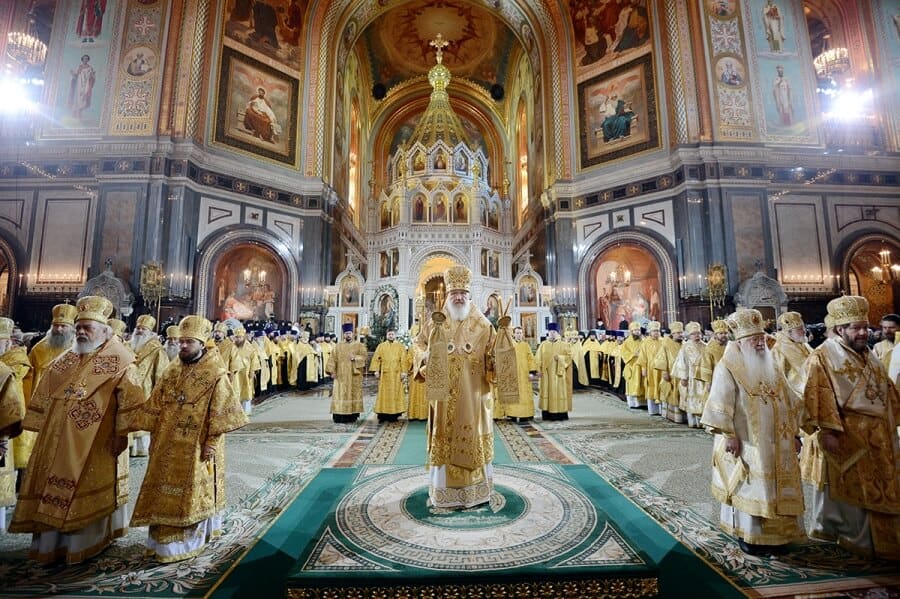Read our special overview of Christmas celebration traditions from various orthodox countries.
Two weeks ago, almost the entire Christian world rejoiced in Christmas celebrations. However, in several Eastern Orthodox churches, the Nativity is celebrated today – on the 7th of January.
This comes as a consequence of not adapting to the reformed Gregorian calendar in 1582 – while the respective countries use the Gregorian calendar in their everyday dealings, their national churches still use the old, Julian calendar. The date January 7th corresponds to December 25th in our everyday calendars. And it’s not only the date that differs in the Orthodox churches of Georgia, Russia, Ukraine, Macedonia, Montenegro and Serbia; these countries all have their distinct tradition when it comes to celebrating this holy Christian day.
In Georgia, a traditional mass walk is organized every Christmas, called Alilo (a different pronunciation of the word Alleluia). People are singing in the streets, dressed as shepherds or soldiers or wearing traditional clothes, carrying banners, wishing each other a merry Christmas and handing sweets to kids. The Georgians even have a distinctive local version of the Christmas tree, called Chichilaki; these decorations are made out of carved, curled white strands of a walnut tree. Georgian Santa is depicted in the Georgian national costume instead of his red uniform common in the West; and even though he doesn’t fly, he still manages to pay a visit to all Georgian kids on the Christmas Eve.
Russia’s Christmas traditions are more similar to the Western ones, thanks to Peter the Great, who introduced a great deal of these in the 17th century. Even though Soviet Russia was formally an atheist state, Christmas customs became a part of the New Year’s celebrations, which included Christmas tree decorations and a secular Santa Claus. Today, Christmas is primarily seen as a religious celebration in Russia; and so, several services are organized in churches countrywide. The traditional Russian dinner, served on Christmas Eve, involves twelve different dishes, to honor the twelve apostles. A wide variety of typical Russian dishes are eaten on this day, most of them consisting of pork!
Ukraine’s multiculturalism makes it one of the rare places where Christmas is celebrated both on December 25th and January 7th. This is especially noticeable in the country’s western part, and it is usually not connected to the specific church that the family belongs to. As in Russia, the main event of this holiday is Christmas Eve, and the dinner with twelve dishes served on this occasion. However, what’s peculiar in Ukraine is the emphasized symbolic role of a sheaf of wheat, indicating Ukraine’s rich wheat crops, which have been the country’s main source of nutrition for centuries. The sheaf is brought into the house at sundown, and it is called Didukh, which translates as Grandfather, and represents the family’s ancestors.
In Macedonia, traditional Christmas bread is made every Christmas Eve. Inside it, there is a coin hidden; at dinner, the host breaks a piece of the loaf for every guest at the table. The person who finds the coin is to expect good fortune in the following year, so naturally, there is always a small good-spirited competition going on between the children at the table! Christmas Eve is the last day of 40-day Christmas fasting in Macedonia, so the food served is made in accordance to the fasting: traditionally, fish and baked beans.
Serbia and Montenegro share traditions with Macedonia, due to their proximity and historical connections; yet, there is an additional ritual typical for these two countries. On Christmas Eve morning, a log is cut out from a young oak tree. This log, called badnjak, is traditionally burned in the house’s fireplace, followed by prayers. This custom, however impractical it may be for the modern household, is still alive: in the cities, families symbolically burn a few oak twigs. Moreover, public Christmas celebrations, including the oak tree burning, are organized every year. A great deal of importance is given to the first person to visit the household in the morning, as they should bring prosperity to the family. These visits are often planned beforehand, and the visitor gets a special present.
What unites all these different customs is the universal homely atmosphere of this holiday, laced with closeness and affection. Accordingly, to those of you who celebrate it today, we wish a warm and merry Christmas!
Christmas traditions vary by religion and culture. But one thing all cultures share is that Christmas is a time for giving gifts. If you are looking for cool Christmas gifts to give this year, custom enamel pins would be a good choice. You can customize them with traditional Christmas elements such as Christmas trees, and Santa or and you can also add special elements like a team logo, family name, or company logo. These cute pins make great decorations on bags, clothes, hats, and many more. You can customize the pins with enamel pin manufacturer GS-JJ.

Support us!
All your donations will be used to pay the magazine’s journalists and to support the ongoing costs of maintaining the site.
Share this post
Interested in co-operating with us?
We are open to co-operation from writers and businesses alike. You can reach us on our email at [email protected]/[email protected] and we will get back to you as quick as we can.









